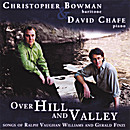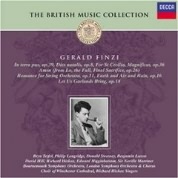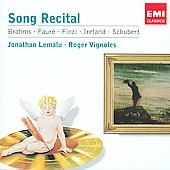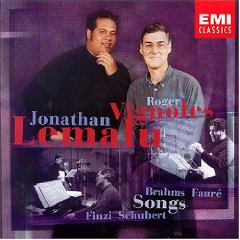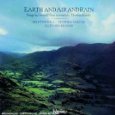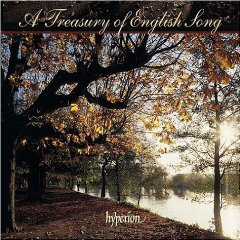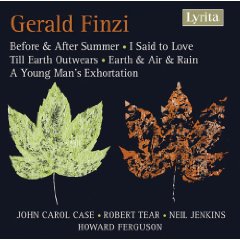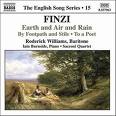When I set out for Lyonnesse
Poet: Thomas Hardy
Date of poem: 1870
Publication date: 1914
Publisher:
Collection:Satires of Circumstance
History of Poem:
Poem
When I Set Out for Lyonnesse |
||
|---|---|---|
| 1 | When I set out for Lyonnesse, | |
| 2 | A hundred miles away, | |
| 3 | The rime was on the spray, | |
| 4 | And starlight lit my lonesomeness | |
| 5 | When I set out for Lyonnesse |
|
| 6 | A hundred miles away. | |
| 7 | What would bechance at Lyonnesse | |
| 8 | While I should sojourn there | |
| 9 | No prophet durst declare, | |
| 10 | Nor did the wisest wizard guess | |
| 11 | What would bechance at Lyonnesse | |
| 12 | While I should sojourn there. | |
| 13 | When I came back from Lyonnesse | |
| 14 | With magic in my eyes, | |
| 15 | All marked with mute surmise | |
| 16 | My radiance rare and fathomless, | |
| 17 | When I came back from Lyonnesse | |
| 18 | With magic in my eyes! | |
(Hardy, 312) |
||
Content/Meaning of the Poem:
Speaker:
Setting:
Purpose:
Idea or theme:
Style:
Form:
Synthesis:
Published comments about the poem:
✦✼✦✼✦✼✦✼✦✼✦✼✦✼✦✼✦✼✦✼✦✼✦✼✦✼✦✼✦✼✦✼✦✼✦
✦✼✦✼✦✼✦✼✦✼✦✼✦✼✦✼✦✼✦✼✦✼✦✼✦✼✦✼✦✼✦✼✦✼✦
Musical Analysis
Composition date:
Publication date:
Publisher: Boosey & Hawkes - Distributed by Hal Leonard Corporation
Tonality:
Transposition:
Duration:
Meter:
Tempo:
Form:
Rhythm:
Melody:
Texture:
Vocal Range:
Tessitura:
Dynamic Range:
Accompaniment:
Published comments about the music:
Pedagogical Considerations for Voice Students and Instructors:
✦✼✦✼✦✼✦✼✦✼✦✼✦✼✦✼✦✼✦✼✦✼✦✼✦✼✦✼✦✼✦✼✦✼✦
✦✼✦✼✦✼✦✼✦✼✦✼✦✼✦✼✦✼✦✼✦✼✦✼✦✼✦✼✦✼✦✼✦✼✦
| Pitch Analysis | ||||||
|---|---|---|---|---|---|---|
| pitch | stanza 1 |
stanza 2 |
stanza 3 |
stanza 4 |
total | |
highest |
A |
|||||
G |
||||||
F |
||||||
E |
||||||
D |
||||||
middle C |
||||||
B |
||||||
A |
||||||
G |
||||||
F |
||||||
lowest |
E |
|||||
| Rhythm Duration Analysis of Vocal Line | |||||
|---|---|---|---|---|---|
| stanza 1 | stanza 2 | stanza 3 | stanza 4 | total | |
16th note |
|||||
8th note |
|||||
dotted 8th |
|||||
quarter note |
|||||
dotted quarter |
|||||
triplet |
|||||
half note |
|||||
dotted half |
|||||
stanza total |
|||||
✦✼✦✼✦✼✦✼✦✼✦✼✦✼✦✼✦✼✦✼✦✼✦✼✦✼✦✼✦✼✦✼✦✼✦
Audio Recordings
Over Hill and Valley: Songs of Ralph Vaughan Williams and Gerald Finzi |
|
|
|
The British Music Collection: Gerald Finzi |
|
|
|
Song Recital |
|
|
|
Songs: Brahms - Faure - Finzi - Schubert |
|
|
|
The Songs of Gerald Finzi to Words by Thomas Hardy
|
|
|
|
A Treasury of English Song |
|
|
|
Gerald Finzi |
|
|
|
The English Song Series - 15 |
|
|
|
✦✼✦✼✦✼✦✼✦✼✦✼✦✼✦✼✦✼✦✼✦✼✦✼✦✼✦✼✦✼✦✼✦✼✦
The following is an analysis of **** by Gerhardus Daniël Van der Watt. Dr. Van der Watt extended permission to post this excerpt from his dissertation on October 8th, 2010. His dissertation dated November 1996, is entitled:
The Songs of Gerald Finzi (1901-1956) To Poems by Thomas Hardy
This excerpt comes from Volume II and begins on page 171 and concludes on page 179. To view the methodology used within Dr. Van der Watt's dissertation please refer to: Methodology - Van der Watt.
1. Poet
Specific background concerning poem:
The poem comes from Satires of Circumstance (1914) and is taken from the section Lyrics and Reveries. It is dated 1870 and in all probability refers to the specific events of 7 March. Hardy, rluctantly, set out at 4 a.m. "for the remote parish mentioned, (st. Juliot - Cornwall) in a county he had never entered" - on a rourney of seeming unimportance - "yet it turned out to have lifelong consequences for him. " (Seymour- Smith 1994: 105-108). It was on this architectural outing that Hardy fell in love with Emma Gifford and "he associated her, as was his wont, with the magical landscape in which she lived." In a letter dated 23 December 1914, Hardy writes to an old acquaintance, Florence Henniker: "I am so glad that you like 'When I set out for Lyonnesse'. It is exactly what happened 44 years ago."
2. Poem
When I Set Out for Lyonnesse |
||
|---|---|---|
| 1 | When I set out for Lyonnesse, | a |
| 2 | A hundred miles away, | b |
| 3 | The rime was on the spray, | b |
| 4 | And starlight lit my lonesomeness | a |
| 5 | When I set out for Lyonnesse |
a |
| 6 | A hundred miles away. | b |
| 7 | What would bechance at Lyonnesse | a |
| 8 | While I should sojourn there | c |
| 9 | No prophet durst declare, | c |
| 10 | Nor did the wisest wizard guess | a |
| 11 | What would bechance at Lyonnesse | a |
| 12 | While I should sojourn there. | c |
| 13 | When I came back from Lyonnesse | a |
| 14 | With magic in my eyes, | d |
| 15 | All marked with mute surmise | d |
| 16 | My radiance rare and fathomless, | a |
| 17 | When I came back from Lyonnesse | a |
| 18 | With magic in my eyes! | d |
(Hardy, 312) |
||
The persona, in this case undoubtedly the poet, sets out for a place called Lyonnesse (Corwall) a long distance off. He is alone and it is cold and dark. It is clear from the second stanza that the poem is written with retrospective knowledge for a strong sense of expectancy is created. None would be able to "guess" what might "bechance", neither an informed holy man (prophet) nor a wise, wourldy man, (wizard). The actual event that takes place at Lyonnesse is purposely omitted to heighten the sense of suspense and mystery. The final stanza only refers to the return journey but there is no doubt from the lexical set: "magic, mute surmise, radiance rare, fathomless", that a significant event has take place. In view of the available biographic information one can assume that Hardy has written a secret love-poem, hardly able to contain his excitement yet fearful blatantly to proclaim this new-found love.
The style is that of a short lyrical ballad with a refrain - a reference to "Lyonnesse". The poem consists of three sextet stanzas with a tailed rhyme scheme (Rime Couee variation: abbaab accaac addaad).
The poem relates the circumstances and atmosphere of an event without stating exactly what happens. The reader is thus drawn into the experience and invited to share with the poet, the sense of loneliness turning into benusment, expectation and then radiance. Omitting the actual event gives the poem a more universal application, for all human beings will experience these sensations in similar circumstances.
Setting
1. Timbre
VOICE TYPE/RANGE
The song is for baritone and the specific range is an augmented eleventh from the second B flat below middle C.
The piano accompaniment covers more than four octaves while the bottom three octaves are used most frequently. Both hands are notated in the bass clef for 61% of the time> Higher pitches are used with the second occurrence of the words "a hundred miles away" (line 6) and the words "with magic in my eyes" (line 18). In both cases the meaning of the text is reinforced by the use of higher pitched chords. It is significant, furthermore, that on the word, "hundred" the composer spaces the extremes of the chord virtually four octaves apart with a gap of just more than two octaves between the two hands. An explicit sense of distance is thereby achieved. The overall sonority is that of dark, expectant or even mystery. There are no actual pedal indications although pedalling would certainly be necessary from bars 26-36 and 54-56. The marking, pp piu sostenuto (b. 23) supports this assumption. Pedalling details are left to the performer. The texture is sparse throughout except in the two more sustained sections.
Portamento accents occur frequently mostly for the purpose of mild accentuation (b. 1, 8, 9, 11, 13, 14, 18, 29, 30, 31, 32, 34, 38, 47, 51, 52, 57). A special note should be made of the two- and four- note descending crotchet motif where each note is marked with portamento (b. 9, 11, 31, 34, 46, 51, 52). Staccatissimo is employed on four occasions (b. 18, 37, 38, 57) and in each case marks the return of the opening piano motif associated with crispness and cold. Staccatos serve the same purpose(b. 3, 18, 29, 31, 34, 40) while half-staccatos serve as a transitional articulation between a more detached and more sustained section (b. 23-25). Long legato lines are the exception (b. 24-28) and are associated with the musing tone of the second stanza where the personal wonders what might happen at Lyonnesse. Two-note slurs are the most frequently used articulation in the right hand while detached-by-rest quavers are the dominant pattern for the left hand.
The atmosphere created by the opening piano interlude sets the dark, expectant atmosphere straight away. It consists of a low, almost grumbling melody in octaves and starts with a trill (which recurs 11 times) that suggests a shiver from cold ("rime on the spray") and excitement. The steady beat of the left hand motif (b. 3-9, and parallel places) suggests the steady passing of time during the journey of a "hundred miles". This motif in interrupted by the piu sostenuto section (b. 23-36) where the "sojourn" in Lyonnesse is suggested by the larger and more static chords. The climax occurs just before the end (b. 55) on the word "magic" and is supported by the accompaniment with a preceding crescendo, fortissimo and widely spaced chord. The postlude of eight bars returns to the opening material and allows this to fade without slackening the pace (b. 61 - senza rall.) A sense of excitement and secretive anticipation is sustained to the very last bar.
2. Duration
METRE
The textual metre of the three stanzas is identical and is a mixture of iambic tetrameters and trimeters (4-3-3-4-4-3). The musical metre is common time with a single bar deviation (b. 49). Some triplet subdivision of the beat does occur but this is related to word rhythm.
Metre variation
There is a single bar in which the metre is changed, namely in bar 49. This bar is shortened(2/4) to allow the word "radiance" to be on a strong beat and to heighten the sense of urgency. The very prominent march-like metre, the Tempo di Marcia indication and the unyielding sense of forward motion (senza rall. b. 21, 61) supports and enhances the meaning of the text, namely suppressed excitement.
Rhythmic motifs
the most prominent motif is four staccato crochets, notated as alternating quavers and quaver rests (motif 1) and occurs 31 times completely (48% of the bars), creating an almost overbearing prominence and certainly creates a sense of time pressing forward. Other motifs that establish themselves consist of two semi-quavers and a quaver tied to a crotchet (motif 2), only in the piano part. This occurs seven times (12% of the bars) and the complementary motif in the voice consisting of a quaver triplet tied to minim (motif 3) derived from the word "Lyonnesse", also occurs seven times (12% of the bars). The only other prominent motif is that of the trill on a dotted crotchet (motif 4) which occurs 11 times (17% of the bars). Lastly, each stanza ends with a prolonged note which serves as a cadence indicator and at the same time allow vocal and pianistic phrases to overlap which heightens the dramatic effect.
Rhythmic activity vs. Rhythmic stagnation
While the rhythmic material is mostly active, the second stanza is set in contrast to this. The longer note values used support the underlying idea in the text, namely that the persona is going to "sojourn" in Lyonnesse. A new motif consisting of a crotchet, two quavers and another crotchet (motif 5), briefly appears which is derived from the words, "What would bechance at" (b. 26) and is echoed four times in the piano part (b. 29, 31, 33, 34). The rhythmic and metric activity, however, returns in bar 37 and continues relentlessly to the end of the song.
Rhythmically perceptive, erroneous and interesting settings
The following words have been perceptively or interestingly dealt with:

The only rhythmic criticism is that of distorting the natural speech rhythm of a particular word in favour of a prolonged pitch (lonesomeness, magic, surprise, fathomless.) In only one place was a pitch lengthened to emphasize a voiced consonant, namely in the word "rime" (b. 10).
The tempo indication is Tempo di Marcia ![]() No deviation from this indiction is present in the score, on the contrary, no slowing down (senza rall.) is specified in the score twice (b. 21, 61) where the composer anticipates the performer might be tempted to slow down.
No deviation from this indiction is present in the score, on the contrary, no slowing down (senza rall.) is specified in the score twice (b. 21, 61) where the composer anticipates the performer might be tempted to slow down.
3. Pitch
an interval analysis of the vocal line is represented in the following table:
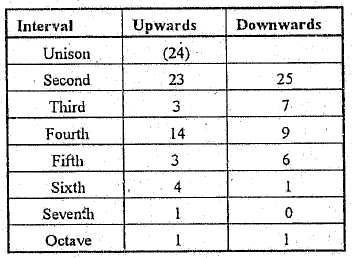
There is an equal distribution of rising and falling intervals: 49 each which represents 40% of the movement. There are 24 pitch repetitions (20%), which is a reasonably high occurrence. Most of these repetitions occur at the upbeat of the first and last line of each stanza. The smaller intervals (unison, seconds and thirds) account for the majority of the intervallic movement at 82 intervals or 67%. The larger intervals are 40, or 33%. Vocally realistic intervals are favoured. The reason/s why the composer has deliberately used certain intervals with certain words are explored in the following table:


Many interval settings are here seen to be very apt. Two instances are of special note, namely the intensification of the meaning by the use of an octave on the second "set out" (b. 14-15) and the setting of "my radiance" with a minor seventh, to heighten the sense of excitement.
Melodic curve
An approximate melodic curve of the vocal line is represented below. Certain words and phrases have been inserted where applicable to show the relationship between the meaning and the rise and fall of the melodic curve.
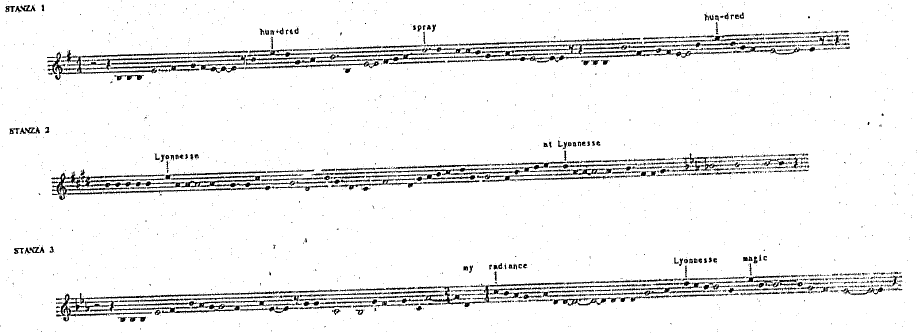
Climaxes
Primary and secondary climaxes are given below:
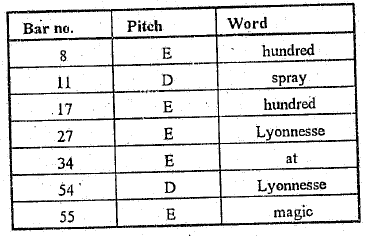
There is no single climatic instance but the highest pitches are the most significant words in the poem with one exception: "at" (b. 34). This word is followed by "Lyonnesse" and can therefore be justified in emphasizing the location of the events described in the poem.
Phrase lengths
The vocal phrases are quite long ![]() but the intention is certainly that the performer should take the liberty of breathing when convenient at appropriate commas in the text. The three stanza ends also contain prolonged final pitches and breathing prior to these will certainly be essential.
but the intention is certainly that the performer should take the liberty of breathing when convenient at appropriate commas in the text. The three stanza ends also contain prolonged final pitches and breathing prior to these will certainly be essential.
The basic key of the song is e natural minor since the seventh is never raised.
Modulation
A number of modulations occur and their functional use is summarised below:

Chromaticism
Apart from several modulations and transitions which are scrupulously text bound, chromaticism is used very sparsely. One moment of note is bar 17 where an A sharp occurs in the bass and is directly related to the meaning of the text at that moment, namely the far-off distance that is suggested with the words, "A hundred miles away". The e natural minor which is used as home-key, has a slightly modal effect, but this is not enough to warrant referring to a modal tonality.
HARMONY AND COUNTERPOINT
Harmony is suggested rather than stated for long section (b. 1-7, 19-21, 41-46, 57-64) in which the piano texture consists of only two parts. There is furthermore a strong tendency for chords to be in first inversion (b. 9-16).
Non-harmonic tones
Many different non-harmonic tones are used. The most prominent is the suspension (b. 25(treble), 36(treble), 37(treble)). These are not particularly text-related other than by obscuring the harmony to enhance the sense of secrecy and suspense. One chain of suspensions in the treble clef of bar 54 intensifies the harmonic activity towards the climax on the word "magic" in the following bar.
Harmonic devices
Inverted pedal point is used quite extensively and effectively in the voice part (b. 18-19, 37-39, 51-52, 57-58). Examples of inverted pedal point are found the final vocal pitches of each stanzas and in two cases are supported by a unison pedal point in the piano part. The function of this is to allow the textual and musical phrases to overlap so that the meaning of each is superimposed on the other. The only other example of pedal point in the piano is that of a three-part chord in bars 55 and 56 at the climactic occurrence of the word "magic".
Counterpoint
There is some suggested imitation between the voice and the piano between bars 32 and 34, where the motif from the voice part (b. 32) is echoed in the piano treble clef in the following bar. There is also a brief imitation in the piano internally in bars 37-38.
The loudness variation is given in the following summary:
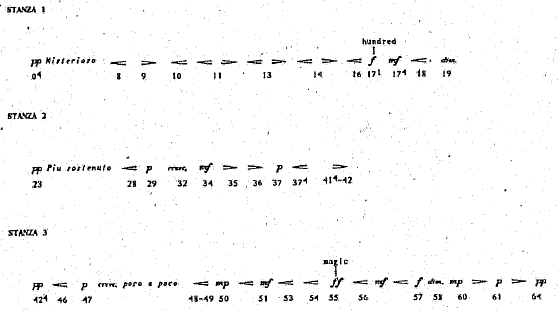
FREQUENCY
There are 40 dynamic markings in the 64 bars which means that 63% of the bars contain dynamic markings. There are also separate indications for the voice in bars 6-7, 9-10, 16 and 57 but these are limited to small crescendos and decrescendos.
RANGE
The dynamic indications range between pp and ff. The former accompanies each stanza opening and the final bar and the latter the climactic moment in bar 55 on the word "magic". The only other indication of note is the f indication in bar 17 on the word "hundred". It is clear that the important words or phrases in the text are highlighted by louder dynamic levels.
VARIETY
The indications used are:
![]()
Dynamic accents
There are two indications. The first with the f in bar 17 in the piano bass and on the final bass chord in bar 64.
DENSITY VARIATION
The textural density varies two and seven parts.
The thickness of the piano part is represented in the following table:
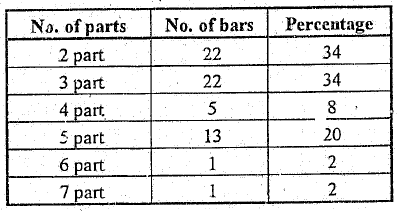
The dominant thickness is that of two- and three-part textures with the exception of the second stanza where a thicker texture prevails to enhance the textual meaning and musing atmosphere. This section is rhythmically slower and therefore allows for the increased thickness in texture.
The structure of the song can be represented as follows:

There is a strong suggestion of ternary form here mainly due to the contrasting material and key in the second stanza. It could also be seen as being varied strophic since the first and last stanzas are treated in a similar way, though not identical.
7. Mood and atmosphere
The basic mood and atmosphere of the poem stay the same throughout the poem:
1. Looking forward to an event with expectation and excitement
2. None could guess at the anture of the event, making it stranger and more dramatic
3. Returning from the event without stating what exactly it was, but with a sense of uncommunicated accomplishment
There is a slight variation in the mood of the second stanza, which is rhythmically slower, texturally denser and in a major key. This coincides with the musing tone in the text and the reference to the sojourn in Lyonnesse. The other two stanzas are rhythmically active, metrically marked, have a relatively thin texture and are mostly in the minor key. All these elements endeavour to portray the mysterious circumstances and anticipation of an unknown fate.
General comment on style
The subject matter of the poem is ballad-like, the persona telling the story of an thrilling, somewhat mysterious prospect which seems to be accomplished by the end of the tale but the reader is never explicitly told what the event was. With certain biographical detail in mind, one would be at liberty to assume that a young man found his love at Lyonnesse and can hardly believe his luck, or contain his excitement. The setting by Finzi supports these analyses completely. There is the indication misterioso, the predominant natural minor key, the marching metre suggested in the accompaniment, the shiver of cold and excitement in the octave trill and the eventual climax on the word "magic". All these and other details discussed earlier, present text and music on a new aesthetic level.
Unpublished Analysis Excerpts
The following is an analysis of When I Set Out For Lyonnesse by Curtis Alan Scheib. Dr. Scheib extended permission to post this excerpt from his dissertation on February 17th, 2012. His dissertation dated 1999, is entitled:
Gerald Finzi's Songs For Baritone On Texts By Thomas Hardy: An Historical And Literary Analysis And Its Effect On Their Interpretation
This excerpt begins on page thirty-six and concludes on page thirty-eight.
When I Set Out for Lyonnesse |
||
|---|---|---|
| When I set out for Lyonnesse, | ||
| A hundred miles away, | ||
| The rime was on the spray, | ||
| And starlight lit my lonesomeness | ||
When I set out for Lyonnesse |
||
| A hundred miles away. | ||
| What would bechance at Lyonnesse | ||
| While I should sojourn there | ||
| No prophet durst declare, | ||
| Nor did the wisest wizard guess | ||
| What would bechance at Lyonnesse | ||
| While I should sojourn there. | ||
| When I came back from Lyonnesse | ||
| With magic in my eyes, | ||
| All marked with mute surmise | ||
| My radiance rare and fathomless, | ||
| When I came back from Lyonnesse | ||
| With magic in my eyes! | ||
(Hardy, 312) |
||
Hardy wrote this poem, which appears to be about a journey to be about a journey to the legendary Arthurian island of Lyonnesse, in 1870. It is generally held that the reference is actually about his first meeting with Emma. Finzi sets the poem as a march and trio, with a ritornello separating the sections, shown in example 3.
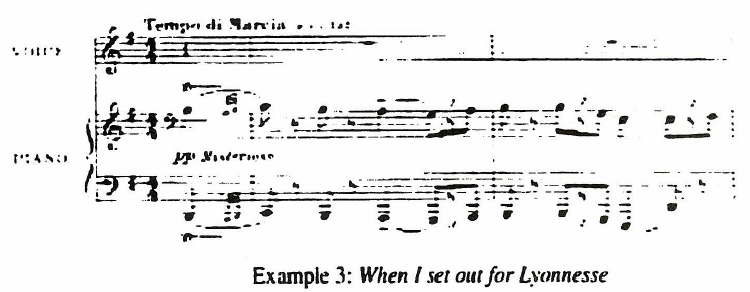
The effect here is one of a procession, the vocal line reaching a jubilant climax with the return from Lyonnesse with "magaic in my eyes" (example 4).

the ritornello then fades off in the distance with one last statement. Harmonically, the song begins in e minor, moving into E Major for the trio which is also the second stanza of the poem. The return of the A section for the third verse is in E flat, a half step too low. Finzi manages to bring us back into the right key however for the triumphant final line of text. The vocal line throughout is one of Finzi's more tuneful, keeping with the spirit of the march. It is the only Hardy song that Finzi orchestrated, scoring it for small orchestra. (Banfield, 210)
The preceding was an analysis of When I Set Out For Lyonnesse by Curtis Alan Scheib. Dr. Scheib extended permission to post this excerpt from his dissertation on February 17th, 2012. His dissertation dated 1999, is entitled:
Gerald Finzi's Songs For Baritone On Texts By Thomas Hardy: An Historical And Literary Analysis And Its Effect On Their Interpretation
The excerpt began on page thirty-six and concluded on page thirty-eight.

